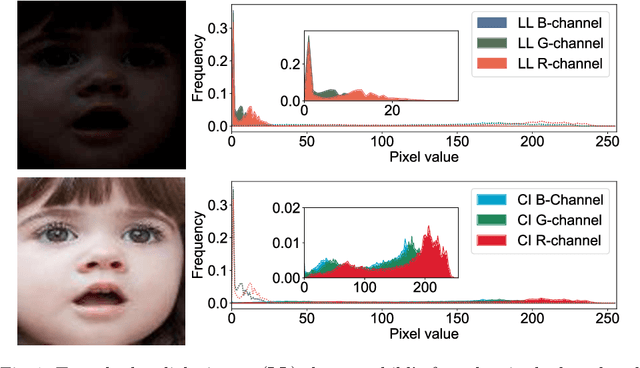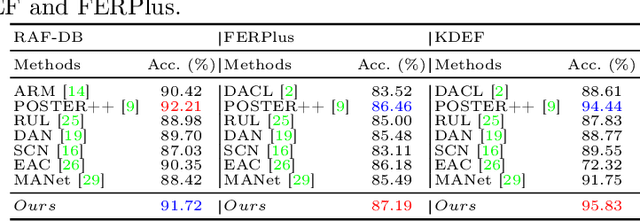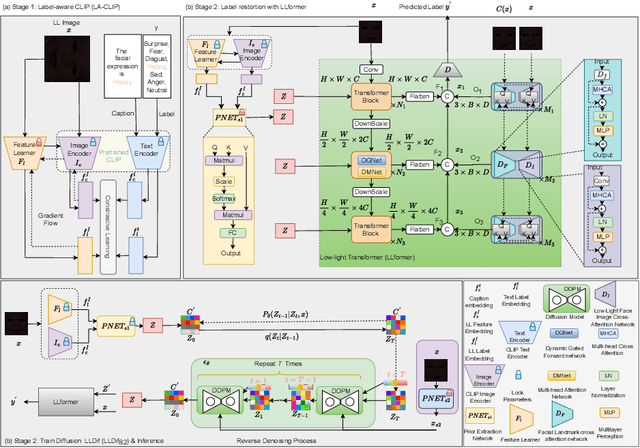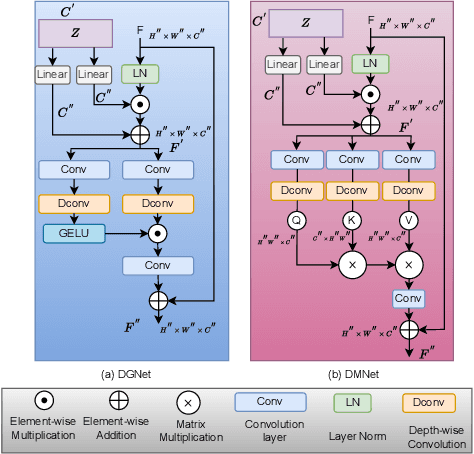Kaihao Zhang
CorrMoE: Mixture of Experts with De-stylization Learning for Cross-Scene and Cross-Domain Correspondence Pruning
Jul 16, 2025Abstract:Establishing reliable correspondences between image pairs is a fundamental task in computer vision, underpinning applications such as 3D reconstruction and visual localization. Although recent methods have made progress in pruning outliers from dense correspondence sets, they often hypothesize consistent visual domains and overlook the challenges posed by diverse scene structures. In this paper, we propose CorrMoE, a novel correspondence pruning framework that enhances robustness under cross-domain and cross-scene variations. To address domain shift, we introduce a De-stylization Dual Branch, performing style mixing on both implicit and explicit graph features to mitigate the adverse influence of domain-specific representations. For scene diversity, we design a Bi-Fusion Mixture of Experts module that adaptively integrates multi-perspective features through linear-complexity attention and dynamic expert routing. Extensive experiments on benchmark datasets demonstrate that CorrMoE achieves superior accuracy and generalization compared to state-of-the-art methods. The code and pre-trained models are available at https://github.com/peiwenxia/CorrMoE.
DAM-VSR: Disentanglement of Appearance and Motion for Video Super-Resolution
Jul 01, 2025Abstract:Real-world video super-resolution (VSR) presents significant challenges due to complex and unpredictable degradations. Although some recent methods utilize image diffusion models for VSR and have shown improved detail generation capabilities, they still struggle to produce temporally consistent frames. We attempt to use Stable Video Diffusion (SVD) combined with ControlNet to address this issue. However, due to the intrinsic image-animation characteristics of SVD, it is challenging to generate fine details using only low-quality videos. To tackle this problem, we propose DAM-VSR, an appearance and motion disentanglement framework for VSR. This framework disentangles VSR into appearance enhancement and motion control problems. Specifically, appearance enhancement is achieved through reference image super-resolution, while motion control is achieved through video ControlNet. This disentanglement fully leverages the generative prior of video diffusion models and the detail generation capabilities of image super-resolution models. Furthermore, equipped with the proposed motion-aligned bidirectional sampling strategy, DAM-VSR can conduct VSR on longer input videos. DAM-VSR achieves state-of-the-art performance on real-world data and AIGC data, demonstrating its powerful detail generation capabilities.
Visual and textual prompts for enhancing emotion recognition in video
Apr 24, 2025Abstract:Vision Large Language Models (VLLMs) exhibit promising potential for multi-modal understanding, yet their application to video-based emotion recognition remains limited by insufficient spatial and contextual awareness. Traditional approaches, which prioritize isolated facial features, often neglect critical non-verbal cues such as body language, environmental context, and social interactions, leading to reduced robustness in real-world scenarios. To address this gap, we propose Set-of-Vision-Text Prompting (SoVTP), a novel framework that enhances zero-shot emotion recognition by integrating spatial annotations (e.g., bounding boxes, facial landmarks), physiological signals (facial action units), and contextual cues (body posture, scene dynamics, others' emotions) into a unified prompting strategy. SoVTP preserves holistic scene information while enabling fine-grained analysis of facial muscle movements and interpersonal dynamics. Extensive experiments show that SoVTP achieves substantial improvements over existing visual prompting methods, demonstrating its effectiveness in enhancing VLLMs' video emotion recognition capabilities.
MaterialMVP: Illumination-Invariant Material Generation via Multi-view PBR Diffusion
Mar 13, 2025Abstract:Physically-based rendering (PBR) has become a cornerstone in modern computer graphics, enabling realistic material representation and lighting interactions in 3D scenes. In this paper, we present MaterialMVP, a novel end-to-end model for generating PBR textures from 3D meshes and image prompts, addressing key challenges in multi-view material synthesis. Our approach leverages Reference Attention to extract and encode informative latent from the input reference images, enabling intuitive and controllable texture generation. We also introduce a Consistency-Regularized Training strategy to enforce stability across varying viewpoints and illumination conditions, ensuring illumination-invariant and geometrically consistent results. Additionally, we propose Dual-Channel Material Generation, which separately optimizes albedo and metallic-roughness (MR) textures while maintaining precise spatial alignment with the input images through Multi-Channel Aligned Attention. Learnable material embeddings are further integrated to capture the distinct properties of albedo and MR. Experimental results demonstrate that our model generates PBR textures with realistic behavior across diverse lighting scenarios, outperforming existing methods in both consistency and quality for scalable 3D asset creation.
PTQ1.61: Push the Real Limit of Extremely Low-Bit Post-Training Quantization Methods for Large Language Models
Feb 18, 2025Abstract:Large Language Models (LLMs) suffer severe performance degradation when facing extremely low-bit (sub 2-bit) quantization. Several existing sub 2-bit post-training quantization (PTQ) methods utilize a mix-precision scheme by leveraging an unstructured fine-grained mask to explicitly distinguish salient weights, while which introduces an extra 1-bit or more per weight. To explore the real limit of PTQ, we propose an extremely low-bit PTQ method called PTQ1.61, which enables weight quantization to 1.61-bit for the first time. Specifically, we first introduce a one-dimensional structured mask with negligibly additional 0.0002-bit per weight based on input activations from the perspective of reducing the upper bound of quantization error to allocate corresponding salient weight channels to 4-bit. For non-salient channels binarization, an efficient block-wise scaling factors optimization framework is then presented to take implicit row-wise correlations and angular biases into account. Different from prior works that concentrate on adjusting quantization methodologies, we further propose a novel paradigm called quantization preprocessing, where we argue that transforming the weight distribution of the pretrained model before quantization can alleviate the difficulty in per-channel extremely low-bit PTQ. Extensive experiments indicate our PTQ1.61 achieves state-of-the-art performance in extremely low-bit quantization. Codes are available at https://github.com/zjq0455/PTQ1.61.
MB-TaylorFormer V2: Improved Multi-branch Linear Transformer Expanded by Taylor Formula for Image Restoration
Jan 08, 2025Abstract:Recently, Transformer networks have demonstrated outstanding performance in the field of image restoration due to the global receptive field and adaptability to input. However, the quadratic computational complexity of Softmax-attention poses a significant limitation on its extensive application in image restoration tasks, particularly for high-resolution images. To tackle this challenge, we propose a novel variant of the Transformer. This variant leverages the Taylor expansion to approximate the Softmax-attention and utilizes the concept of norm-preserving mapping to approximate the remainder of the first-order Taylor expansion, resulting in a linear computational complexity. Moreover, we introduce a multi-branch architecture featuring multi-scale patch embedding into the proposed Transformer, which has four distinct advantages: 1) various sizes of the receptive field; 2) multi-level semantic information; 3) flexible shapes of the receptive field; 4) accelerated training and inference speed. Hence, the proposed model, named the second version of Taylor formula expansion-based Transformer (for short MB-TaylorFormer V2) has the capability to concurrently process coarse-to-fine features, capture long-distance pixel interactions with limited computational cost, and improve the approximation of the Taylor expansion remainder. Experimental results across diverse image restoration benchmarks demonstrate that MB-TaylorFormer V2 achieves state-of-the-art performance in multiple image restoration tasks, such as image dehazing, deraining, desnowing, motion deblurring, and denoising, with very little computational overhead. The source code is available at https://github.com/FVL2020/MB-TaylorFormerV2.
Visual Style Prompt Learning Using Diffusion Models for Blind Face Restoration
Dec 30, 2024



Abstract:Blind face restoration aims to recover high-quality facial images from various unidentified sources of degradation, posing significant challenges due to the minimal information retrievable from the degraded images. Prior knowledge-based methods, leveraging geometric priors and facial features, have led to advancements in face restoration but often fall short of capturing fine details. To address this, we introduce a visual style prompt learning framework that utilizes diffusion probabilistic models to explicitly generate visual prompts within the latent space of pre-trained generative models. These prompts are designed to guide the restoration process. To fully utilize the visual prompts and enhance the extraction of informative and rich patterns, we introduce a style-modulated aggregation transformation layer. Extensive experiments and applications demonstrate the superiority of our method in achieving high-quality blind face restoration. The source code is available at \href{https://github.com/LonglongaaaGo/VSPBFR}{https://github.com/LonglongaaaGo/VSPBFR}.
* Published at Pattern Recognition; 13 pages, 11 figures
All-in-one Weather-degraded Image Restoration via Adaptive Degradation-aware Self-prompting Model
Nov 12, 2024



Abstract:Existing approaches for all-in-one weather-degraded image restoration suffer from inefficiencies in leveraging degradation-aware priors, resulting in sub-optimal performance in adapting to different weather conditions. To this end, we develop an adaptive degradation-aware self-prompting model (ADSM) for all-in-one weather-degraded image restoration. Specifically, our model employs the contrastive language-image pre-training model (CLIP) to facilitate the training of our proposed latent prompt generators (LPGs), which represent three types of latent prompts to characterize the degradation type, degradation property and image caption. Moreover, we integrate the acquired degradation-aware prompts into the time embedding of diffusion model to improve degradation perception. Meanwhile, we employ the latent caption prompt to guide the reverse sampling process using the cross-attention mechanism, thereby guiding the accurate image reconstruction. Furthermore, to accelerate the reverse sampling procedure of diffusion model and address the limitations of frequency perception, we introduce a wavelet-oriented noise estimating network (WNE-Net). Extensive experiments conducted on eight publicly available datasets demonstrate the effectiveness of our proposed approach in both task-specific and all-in-one applications.
LLDif: Diffusion Models for Low-light Emotion Recognition
Aug 08, 2024



Abstract:This paper introduces LLDif, a novel diffusion-based facial expression recognition (FER) framework tailored for extremely low-light (LL) environments. Images captured under such conditions often suffer from low brightness and significantly reduced contrast, presenting challenges to conventional methods. These challenges include poor image quality that can significantly reduce the accuracy of emotion recognition. LLDif addresses these issues with a novel two-stage training process that combines a Label-aware CLIP (LA-CLIP), an embedding prior network (PNET), and a transformer-based network adept at handling the noise of low-light images. The first stage involves LA-CLIP generating a joint embedding prior distribution (EPD) to guide the LLformer in label recovery. In the second stage, the diffusion model (DM) refines the EPD inference, ultilising the compactness of EPD for precise predictions. Experimental evaluations on various LL-FER datasets have shown that LLDif achieves competitive performance, underscoring its potential to enhance FER applications in challenging lighting conditions.
Follow-Your-Pose v2: Multiple-Condition Guided Character Image Animation for Stable Pose Control
Jun 05, 2024



Abstract:Pose-controllable character video generation is in high demand with extensive applications for fields such as automatic advertising and content creation on social media platforms. While existing character image animation methods using pose sequences and reference images have shown promising performance, they tend to struggle with incoherent animation in complex scenarios, such as multiple character animation and body occlusion. Additionally, current methods request large-scale high-quality videos with stable backgrounds and temporal consistency as training datasets, otherwise, their performance will greatly deteriorate. These two issues hinder the practical utilization of character image animation tools. In this paper, we propose a practical and robust framework Follow-Your-Pose v2, which can be trained on noisy open-sourced videos readily available on the internet. Multi-condition guiders are designed to address the challenges of background stability, body occlusion in multi-character generation, and consistency of character appearance. Moreover, to fill the gap of fair evaluation of multi-character pose animation, we propose a new benchmark comprising approximately 4,000 frames. Extensive experiments demonstrate that our approach outperforms state-of-the-art methods by a margin of over 35\% across 2 datasets and on 7 metrics. Meanwhile, qualitative assessments reveal a significant improvement in the quality of generated video, particularly in scenarios involving complex backgrounds and body occlusion of multi-character, suggesting the superiority of our approach.
 Add to Chrome
Add to Chrome Add to Firefox
Add to Firefox Add to Edge
Add to Edge